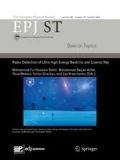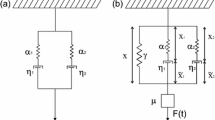Abstract
Paper on the creep tide theory and its applications to satellites and planets with emphasis on a new set of differential equations allowing easier numerical studies. The creep tide theory is a new paradigm that does not fix a priori the tidal deformation of the body, but considers the deformation as a low-Reynolds-number flow. The evolution under tidal forces is ruled by an approximate solution of the Navier–Stokes equation depending on the body’s viscosity with no ad hoc assumptions on its shape and orientation. It reproduces closely the results of Darwinian theories in the case of gaseous planets and stars, but the results are completely different in the case of stiff satellites and planets. It explains the tidal dissipations of Enceladus and Mimas. The extension of the theory to nonhomogeneous icy satellites with a subsurface ocean allows the amplitude of the forced oscillations around synchronization (librations) to be better determined.
Similar content being viewed by others
References
S. Ferraz-Mello, EPSC Abstracts 7, EPSC2012-284 (2012).
S. Ferraz-Mello, Dissipation and synchronization due to creeping tides, in American Astronomical Society, DDA Meeting No. 43, id.8.0 6 (2012).
S. Ferraz-Mello, Celest. Mech. Dyn. Astr. 116, 109 (2013).
M.E. Alexander, Astrophys. Sp. Sci. 23, 459 (1973).
M. Efroimsky, J.G. Williams, Celest. Mech. Dyn. Astron. 104, 257 (2009).
M. Efroimsky, V. Lainey, J. Geophys. Res. 112, E12003 (2007).
V.V. Makarov, M. Efroimsky, Astrophys. J. 764, 27 (2013).
B. Noyelles, J. Frouard, V. Makarov, M. Efroimsky, Icarus 241, 26 (2014).
M. Efroimsky, Astrophys. J. 746, 150 (2012).
M. Efroimsky, Celest. Mech. Dyn. Astr. 112, 283 (2012).
M. Efroimsky, Astron. J. 150, 98 (2015).
S. Ferraz-Mello, A. Rodrguez, H. Hussmann, Celest. Mech. Dyn. Astr. 101, 171 (2008) [Errata: Celest. Mech. Dyn. Astr. 104, 319 (2009)].
H.A. Folonier, S. Ferraz-Mello, E. Andrade-Ines, Celest. Mech. Dyn. Astr. 130, 78 (2018).
S. Ferraz-Mello, Celest. Mech. Dyn. Astr. 122 (2015) 359 [Errata: Celest. Mech. Dyn. Astr. 130, 78 (2018), p. 20].
G. Arfken, H.J. Weber, Mathematical Methods for Physicists, 6th ed. (Elsevier, Burlington, MA, 2005).
A.C.M. Correia, G. Boué, J. Laskar, A. Rodrguez, Astron. Astrophys. 571, A50 (2014).
S. Ferraz-Mello, Astron. Astrophys. 579, A97 (2015).
G.O. Gomes, H.A. Folonier, S. Ferraz-Mello, Celest. Mech. Dyn. Astr. 131, 56 (2019).
S. Ferraz-Mello, H. Folonier, M. Tadeu dos Santos, S. Csizmadia, J.D. do Nascimento, M. Pätzold, Astrophys. J. 807, 78 (2015).
R. Tajeddine, N. Rambaux, V. Lainey, S. Charnoz, et al., Science 346, 322 (2014).
P. Hut, Astron. Astrophys. 99, 126 (1981).
G.H. Darwin, Philos. Trans. 171 (1880) 713 [repr. Scientific Papers Vol. II, Cambridge, 1908].
H. Essén, Int. J. Geosci. 5, 555 (2014).
P. Goldreich, MNRAS 126, 257 (1963).
W.M. Kaula, Rev. Geophys. 3, 661 (1964).
G.F. MacDonald, Rev. Geophys. 2, 467 (1964).
H.A. Folonier, S. Ferraz-Mello, Tidal dissipation in differentiated synchronized Icy satelites, Application to Enceladus (submitted).
H.A. Folonier, S. Ferraz-Mello, Celest. Mech. Dyn. Astr. 129, 359 (2017).
S. Ferraz-Mello, Planetary tides: theories, in Satellite Dynamics and Space Missions, edited by G. Baù, et al. (Springer-Nature, Switzerland, 2019), pp. 1–50.
G. Beutler, Methods of Celestial Mechanics (Springer, Berlin, 2005).
S. Ferraz-Mello, C. Beaugé, T.A. Michtchenko, Celest. Mech. Dyn. Astr. 87, 99 (2003).
L.M. Cathles, Viscosity of the Earth’s Mantle (Princeton University Press, Princeton, 2015).
P. Melchior, Earth Tides Geophysical Surveys 1, 275 (1974).
H. Folonier, S. Ferraz-Mello, K.V. Kholshevnikov, Celest. Mech. Dyn. Astron. 122, 183 (2015).
R. Haas, H. Schuh, J. Wünsch, Determination of tidal parameters from VLBI Data, in 11th Working Meeting on European VLBI for Geodesy and Astrometry, Onsala Sweden (1996), pp. 162–171.
R.D. Ray, R.J. Eanes, B.F. Chao, Nature 381, 595 (1996).
R.D. Ray, R.J. Eanes, F.G. Lemoine, Geophys. J. Int. 144, 471 (2001).
C. Doglioni, A. Ismail-Zadeh, G. Panza, F. Riguzzi, Phys. Earth Planet. Inter. 189, 1 (2011).
Author information
Authors and Affiliations
Corresponding author
Additional information
Publisher’s Note
The EPJ Publishers remain neutral with regard to jurisdictional claimsin published maps and institutional affiliations.
Rights and permissions
About this article
Cite this article
Ferraz-Mello, S., Beaugé, C., Folonier, H.A. et al. Tidal friction in satellites and planets. The new version of the creep tide theory. Eur. Phys. J. Spec. Top. 229, 1441–1462 (2020). https://doi.org/10.1140/epjst/e2020-900184-5
Received:
Revised:
Published:
Issue Date:
DOI: https://doi.org/10.1140/epjst/e2020-900184-5




